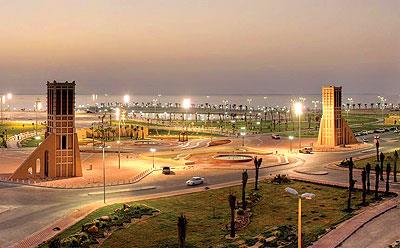Introduction
Eastern Province is home to most of the oil production of Saudi Arabia. Located in the eastern part of the Kingdom of Saudi Arabia it is like a jewel with bright colors. It boasts beautiful gardens and sandy beaches on the shores of the Arabian Gulf. It is a combination of the emerald green sea, beautiful Corniches, and green Oases, in addition to a sprawling desert where sights extend for miles together to distant horizons.
To enjoy a short holiday or weekend away from the pressure of work, you can head to Marjan Island here and get a breathtaking view in the evenings. If you want to know the history of the city, do visit Al Dammam Regional Museum, which has several halls bedecked with Neolithic and transition period artifacts.
Also to spend an interesting shopping time you will find many distinct shopping centers to meet your exotic needs.
Dammam & Khobar
Dammam is the capital of the Eastern Region, and home to the vast sea, beautiful beaches, and exotic fishing places. It is a favorite destination for tourists from different parts of the Kingdom. Dammam is known to be the oldest inhabited place due to the discovery of many ancient artifacts in the Rakah district, alluding that it was a popular living site for a long time in the past.
Khobar is called the Pearl of the Arabian Gulf and the Eastern bride. It is distinguished for its prosperous commercial malls and rich city locations, making it one of the most beautiful cities of the Arabian Gulf.
Discover the charming beaches
On the east coast of Saudi Arabia, you can see hundreds of fishing boats competing for space on the surface of the sea, as marine fishing was the traditional occupation here since ancient times, which is still practiced by some. The history of diving for pearls in the deep gulf remains fresh in the memory of the region. When a visitor goes to the waterfront areas, he will find people merrymaking and joyful.
Starting with the most famous and popular beach Half Moon Bay, the cornice extends from Al Khobar to Dammam and finally ends at the integrated services waterfront in Ras Tanura and Jubail, where landscaped private sitting places and children play areas are beautifully crafted and maintained. Along the corniche, the corridors are equipped for hiking and biking, with resorts and chalets catering to the visitors. These beaches are most visited as a family destination by locals and visitors in the region.
Popular Cuisine & Traditional Clothing
Dates, wheat, milk, are the essential components of food in the Eastern region. Molasses extracted from dates are used in the preparation of many of the popular dishes, such as porridge (Al-Muhammad and Aseedah) for breakfast and dinner, which are the main meals of the family. Breakfast consists of a combination of dates, coffee, milk, baked bread, eggs, vermicelli (Shi airish) plus white tea. Lunch usually is rice with meat or shrimps, or Al Wadmah (onions and dried fish in summer). For dinner, you can have very tasty dishes like Al Mufallaq, Al Jireesh, Al Harees, and Al Thereed. Sheep and fish meat are used mainly in the local dishes. Kabsah with fish and shrimps is considered the most recognized delicacy in the Eastern region.
Traditional Clothing that is locals of the Eastern region boasts the most beautiful forms of dresses, which reflect the prestige and elegance of the region. Men’s dress consists of loose garments that cover the body up to the lower leg. Dangling at the neck of the thobe dress is a tuft of threads called (Krkoshah). In addition, men wear a headcloth called ghutra or shimmag, which has white or striped triangles. On the top of Ghutra, a black rope-like doubled cord called Igal is worn in order to hold the Ghutra in place. During winter, a cloak made of sheepskin or wool is worn over the thobe. As for women, they wear a full-length loose gown embroidered with silk and gold. The headscarf is made of black cloth decorated with golden threads with an opening for the face in front and the rest of the headdress is let loose on the shoulders and back.

